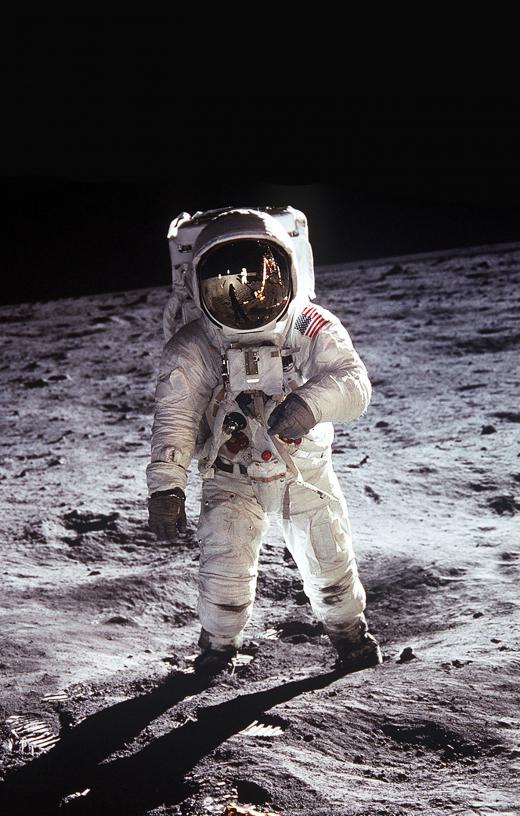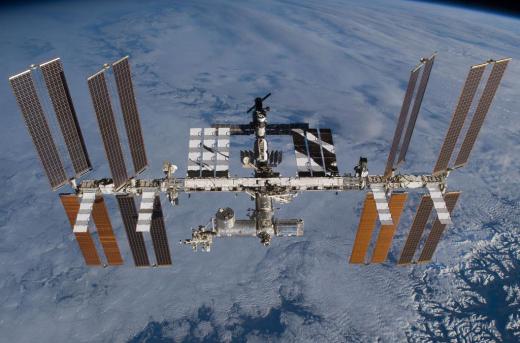What is a Space Helmet?
The space helmet has been one of the most recognizable symbols of space exploration for decades. The iconic piece of equipment has show up in numerous aspects of both popular culture and scientific reality including the early movie serials of the 1930s like Flash Gordon, B-Movies such as Robot Monster in the 1950s, photographs of helmet-wearing astronauts on the moon from the 1960s and 1970s, and the videos of spacewalkers repairing the International Space Station (ISS). The space helmet is one of the most important parts of a space suit, and is required for survival in the harsh conditions of outer space.
The space helmet fulfills three primary purposes and many smaller ones. First, it allows pressure to be maintained around the wearer’s head while in the vacuum of space. Second, the space helmet provides breathable oxygen for the person wearing it. Third, the helmet allows the wearer to see, while also providing protection against extreme light, radiation, and other harmful rays. The helmet can also house other important items including communications gear, water, food, padding, and thermal coverings.

Most space helmets have a similar look to them - they tend to be both hard-shelled and bubble-shaped. The hard shell assists in maintaining pressure in space’s vacuum. The bubble shape is necessary in most cases because the helmet is attached to the space suit and does not turn or move. The person wearing the attached helmet must be able to turn their head inside of it, resulting in the helmet’s large bulbous form.

Another common space helmet feature is the visor system. There have been many model types and names for the system, including the Lunar Extravehicular Visor Assembly (LEVA), Skylab Extravehicular Visor Assembly (SEVA), and Extravehicular Visor Assembly (EVA or EVVA). The most prominent part of the visor system is easily recognized by its golden color, and is, in fact, coated by a thin layer of gold. This visor protects the wearer from the sun’s harmful rays that are normally filtered by the Earth’s atmosphere. An additional shaded but transparent visor may be included for protection. Opaque shades on the sides and top of the visor system can be pulled down to block light when necessary.

Communication is another important aspect of the helmet. In some spacesuits, microphones and earphones that connect to a radio system are built into the helmet so that explorers can communicate while in space. Other spacesuits have a separate piece of headgear that is worn under the helmet. This additional piece is called the Communications Carrier Assembly in NASA suits, and has been nicknamed the “Snoopy Cap” in popular culture.
AS FEATURED ON:
AS FEATURED ON:














Discussion Comments
@Ana1234 - It's difficult to predict the future but I'm not sure where they could go with the helmet. It might seem unwieldy to us, but remember there is no gravity in space and very little on the moon, so it wouldn't weigh that much when they are wearing it.
They really need something that strong and stiff in order to protect against the vacuum. I don't know how they could ever get away with anything that was smaller or more elegant looking because it would be much more uncomfortable to wear.
I suspect what they will end up doing for space tourists is making an area where they can visit the moon under a dome or something that acts the same way as the helmet. But I can't imagine the helmet itself changing all that much in shape or function.
@MrsPramm - Well, I imagine that they provide food and water the same way a runner might get them. You just put a pack of liquid food or water on the body and place a tube near the mouth of the person who needs it. That would be one reason they have to be able to turn their heads when wearing the helmet. I imagine the tube would be put somewhere to the side of them.
I think it will be interesting to see what the space helmet evolves into in the future. It's very unwieldy at the moment and I suspect we can do better. We'll have to do better if they ever want to get serious about space tourism.
I didn't realize that the helmet was actually covered in a thin layer of gold. It must be very thin for the astronaut to be able to see through it. That's a really cool fact.
I guess I never really thought about those helmets as being anything more than a kind of fishbowl protection for the astronaut. They must be fascinating on the inside, with all that different technology and places for food and water and things like that.
Post your comments